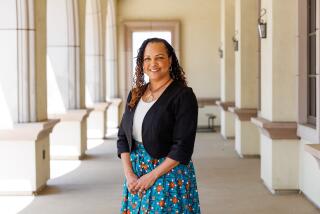The Power of Staying Positive
- Share via
It was his last week of high school, and Johnny Palacio navigated the hallways like an accomplished veteran, weaving through the throngs of students with determination.
Every few moments, he accepted a high-five from another student.
“He’s just a freshman,” Johnny said of the latest greeter. “But it’s OK. He probably just knows I’m a senior. Seniors rule!”
The 18-year-old with Down syndrome graduated from Santa Ana High School last week, after being immersed for four years in a curriculum that was tailored to focus more on his social skills and personal growth than on meeting all the academic requirements posed for most students.
Johnny found high school pretty straightforward.
“I just go to class and do the work and eat some lunch and then go home,” he said. “Oh! And sometimes I play the piano: ‘Skip to My Lou.’ ”
His parents and teachers said keeping Johnny on task through high school was rewarding, frustrating and more difficult than they ever had imagined.
“It’s taken a huge commitment from everyone, from the principal to the teachers, right down to the students and security guards,” said Deborah Misserville, former chairwoman of the special-education department at Santa Ana High. “That’s what made it work. Everyone saw [Johnny’s] progress, and because everyone had something to do with it, it made us all feel good.”
The early days were the hardest.
As a freshman, Johnny was notorious for bolting away from the special education assistants who were assigned to walk him to class and watch over him each day. He threw tantrums in front of other students without warning. He sat on the ground and refused to get up, wrapping his arms around a bench or tree to ward off those who came near.
Teachers and security guards “basically had to carry him to class sometimes,” said Carol Davis, one of Johnny’s aides. “Oh, how I remember those days.”
*
Over the years, though, Johnny’s outbursts and behavioral lapses occurred less and less, officials said. His parents were called every few weeks to pick him up, but toward the end of his high school years, rarely were they alerted to one of Johnny’s “bad days.”.
And his teachers can’t recall the last time he was sent to “timeout”--punishment that was especially hard for Johnny, a social butterfly who craves attention and adores people.
“There is nothing he hates more than timeout,” said his mother, Sonia Palacio. “It’s torture.”
His parents said they were apprehensive four years ago about enrolling their son in Santa Ana High. What if he regressed instead of flourished, overwhelmed by the crowds of students and the size of the school? How cruel would the students be to him? Would the vivacious and gentle personality that endears Johnny to most people change somehow?
A little assurance, and even some coaxing, from school officials persuaded Sonia and John Palacio to take the risk.
“We are so grateful that we did,” John Palacio said. “Johnny has grown so much. He is curious about things. He isn’t afraid to explore or question the things around him. He takes chances that he never would before, because he wants to learn.”
Although there are more than 100 special-education students at the high school, Johnny was the only one with Down syndrome, a condition that causes mental retardation and affects nearly one in every 650 babies nationwide.
The mainstreaming process at Santa Ana High allowed him to join the general student population for most of the day, accompanied to classes by special-education aides who sat with him and helped his regular-education teachers.
Rather than focusing on academic skills--Johnny has an IQ of about 50--his teachers emphasized social skills.
To the relief of Johnny’s parents, most of the school’s nearly 3,000 students were friendly toward Johnny, even supportive. His teachers said Johnny became one of the most popular students at the school, and they watched him wriggle his way into the hearts of his classmates.
“He’s an all right kid,” said David Aguilar, 16. “A little rowdy sometimes, but all right. He’s like the class clown or something.”
Said 17-year-old Rebecca Chavez: “He’s very sweet. He loves to give hugs.”
*
As the school year drew to a close and graduation approached, Johnny’s teachers celebrated his accomplishments and remembered the milestones that brought him so far. They were less likely to recall his difficult early days of high school, although they were suddenly able to laugh at even those memories.
Mostly they talked, like a group of doting relatives, about how Johnny has grown up. He took the bus, walked to class, did his homework and, during his senior year, worked part time at a Wal-Mart. He can read, write and swim. He wants to learn. He is proudest when he can do things on his own.
“Look at him now,” said Cecilia Aguinaga, one of Johnny’s favorite teaching assistants. On the verge of tears, she wrapped an arm around his shoulders and gave him a squeeze. “He’s a fine young man. And he’s on his way.”
*
Johnny hardly understands all the fuss. He begins adult transition classes this summer at Santa Ana College, where he will continue to polish his social skills and study more advanced lessons that will help prepare him for his and his parents’ ultimate goal: independent living.
“I just want to get my license and drive a car someday,” he said. “That’s all. Oh! And go to Las Vegas. Piece of cake.”
More to Read
Sign up for Essential California
The most important California stories and recommendations in your inbox every morning.
You may occasionally receive promotional content from the Los Angeles Times.













